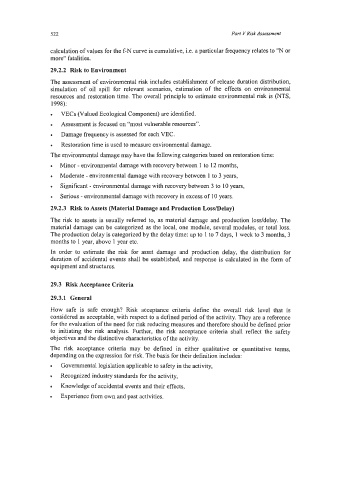Page 546 - Marine Structural Design
P. 546
522 Pari V Risk Assessment
calculation of values for the f-N curve is cumulative, i.e. a particular frequency relates to "N or
more" fatalities.
29.2.2 Risk to Environment
The assessment of environmental risk includes establishment of release duration distribution,
simulation of oil spill for relevant scenarios, estimation of the effects on environmental
resources and restoration time. The overall principle to estimate environmental risk is (NTS,
1998):
VECs (Valued Ecological Component) are identified.
Assessment is focused on "most vulnerable resources".
Damage frequency is assessed for each VEC.
Restoration time is used to measure environmental damage.
The environmental damage may have the following categories based on restoration time:
Minor - environmental damage with recovery between 1 to 12 months,
Moderate - environmental damage with recovery between 1 to 3 years,
Significant - environmental damage with recovery between 3 to 10 years,
Serious - environmental damage with recovery in excess of 10 years.
29.2.3 Risk to Assets (Material Damage and Production LossDelay)
The risk to assets is usually referred to, as material damage and production losddelay. The
material damage can be categorized as the local, one module, several modules, or total loss.
The production delay is categorized by the delay time: up to 1 to 7 days, 1 week to 3 months, 3
months to 1 year, above 1 year etc.
In order to estimate the risk for asset damage and production delay, the distribution for
duration of accidental events shall be established, and response is calculated in the form of
equipment and structures.
29.3 Risk Acceptance Criteria
29.3.1 General
How safe is safe enough? Risk acceptance criteria define the overall risk level that is
considered as acceptable, with respect to a defined period of the activity. They are a reference
for the evaluation of the need for risk reducing measures and therefore should be defined prior
to initiating the risk analysis. Further, the risk acceptance criteria shall reflect the safety
objectives and the distinctive characteristics of the activity.
The risk acceptance criteria may be defined in either qualitative or quantitative tenns,
depending on the expression for risk. The basis for their definition includes:
Governmental legislation applicable to safety in the activity,
Recognized industry standards for the activity,
Knowledge of accidental events and their effects,
Experience from own and past activities.

